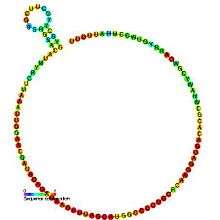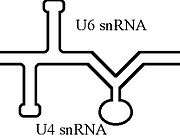U6 spliceosomal RNA
| U6 spliceosomal RNA | |
|---|---|
 Predicted secondary structure and sequence conservation of U6 | |
| Identifiers | |
| Symbol | U6 |
| Rfam | RF00026 |
| Other data | |
| RNA type | Gene; snRNA; splicing |
| Domain(s) | Eukaryota |
| GO | 0000351 0000353 0030621 0005688 0046540 |
| SO | 0000396 |
U6 snRNA is the non-coding small nuclear RNA (snRNA) component of U6 snRNP (small nuclear ribonucleoprotein), an RNA-protein complex that combines with other snRNPs, unmodified pre-mRNA, and various other proteins to assemble a spliceosome, a large RNA-protein molecular complex upon which splicing of pre-mRNA occurs. Splicing, or the removal of introns, is a major aspect of post-transcriptional modification and takes place only in the nucleus of eukaryotes.
The RNA sequence of U6 is the most highly conserved across species of all five of the snRNAs involved in the spliceosome,[1] suggesting that the function of the U6 snRNA has remained both crucial and unchanged through evolution.
It is common in vertebrate genomes to find many copies of the U6 snRNA gene or U6-derived pseudogenes.[2] This prevalence of "back-ups" of the U6 snRNA gene in vertebrates further implies its evolutionary importance to organism viability.
The U6 snRNA gene has been isolated in many organisms, including C. elegans.[3] Among them, Baker's yeast (Saccharomyces cerevisiae) is a commonly used model organism in the study of snRNAs.
Role of U6 snRNA
Base-pair specificity of the U6 snRNA allows the U6 snRNP to bind tightly to the U4 snRNA and loosely to the U5 snRNA of a triple-snRNP during the initial phase of the splicing reaction. As the reaction progresses, the U6 snRNA is unzipped from U4 and binds to the U2 snRNA. At each stage of this reaction, the U6 snRNA secondary structure undergoes extensive conformational changes.[4]
The association of U6 snRNA with the 5' end of the intron via base-pairing during the splicing reaction occurs prior to the formation of the lariat (or lasso-shaped) intermediate, and is required for the splicing process to proceed. The association of U6 snRNP with U2 snRNP via base-pairing forms the U6-U2 complex, a structure that comprises the active site of the spliceosome.[5]:433–437
Secondary Structure
While the putative secondary structure consensus base pairing is confined to a short 5' stem-loop, much more extensive structures have been proposed for specific organisms such as in yeast.[6] In addition to the 5' stem loop, all confirmed U6 snRNAs can form the proposed 3' intramolecular stem loop.[7]

The U6 snRNA is known to form an extensive base-pair interactions with U4 snRNA.[8] This interaction has been shown to be mutually exclusive to that of the 3' intramolecular stem loop.[4]
Associated Proteins

Free U6 snRNA is found to be associated with the proteins Prp24 and the LSms.[9] Prp24 is thought to form an intermediate complex with the U6 snRNA, in order to facilitate the extensive base-pairing between the U4 and U6 snRNAs,[10][11] and the Lsms may aid in Prp24 binding. The approximate location of these protein binding domains was determined,[12] and the proteins were later visualized by electron microscopy.[13] This study suggests that in the free form of U6, Prp24 binds to the telestem and the uradine-rich 3' tail of the U6 snRNA is threaded through the ring of Lsms.
See also
References
- ↑ Brow DA, Guthrie C (July 1988). "Spliceosomal RNA U6 is remarkably conserved from yeast to mammals". Nature. 334 (6179): 213–218. doi:10.1038/334213a0. PMID 3041282.
- ↑ Marz M, Kirsten T, Stadler PF (December 2008). "Evolution of spliceosomal snRNA genes in metazoan animals". J. Mol. Evol. 67 (6): 594–607. doi:10.1007/s00239-008-9149-6. PMID 19030770.
- ↑ Thomas J, Lea K, Zucker-Aprison E, Blumenthal T (May 1990). "The spliceosomal snRNAs of Caenorhabditis elegans". Nucleic Acids Res. 18 (9): 2633–2642. doi:10.1093/nar/18.9.2633. PMC 330746
 . PMID 2339054.
. PMID 2339054. - 1 2 Fortner DM, Troy RG, Brow DA (January 1994). "A stem/loop in U6 RNA defines a conformational switch required for pre-mRNA splicing". Genes Dev. 8 (2): 221–233. doi:10.1101/gad.8.2.221. PMID 8299941.
- ↑ Weaver, Robert J. (2008). Molecular Biology. Boston: McGraw Hill Higher Education. ISBN 0-07-127548-7.
- ↑ Karaduman R, Fabrizio P, Hartmuth K, Urlaub H, Lührmann R (March 2006). "RNA structure and RNA-protein interactions in purified yeast U6 snRNPs". J. Mol. Biol. 356 (5): 1248–1262. doi:10.1016/j.jmb.2005.12.013. PMID 16410014.
- ↑ Butcher SE, Brow DA (June 2005). "Towards understanding the catalytic core structure of the spliceosome". Biochem. Soc. Trans. 33 (Pt 3): 447–9. doi:10.1042/BST0330447. PMID 15916538.
- ↑ Orum H, Nielsen H, Engberg J (November 1991). "Spliceosomal small nuclear RNAs of Tetrahymena thermophila and some possible snRNA-snRNA base-pairing interactions". J. Mol. Biol. 222 (2): 219–232. doi:10.1016/0022-2836(91)90208-N. PMID 1960724.
- ↑ Stevens SW, Barta I, Ge HY, Moore RE, Young MK, Lee TD, Abelson J (November 2001). "Biochemical and genetic analyses of the U5, U6, and U4/U6 x U5 small nuclear ribonucleoproteins from Saccharomyces cerevisiae". RNA. 7 (11): 1543–53. PMC 1370197
 . PMID 11720284.
. PMID 11720284. - ↑ Jandrositz A, Guthrie C (February 1995). "Evidence for a Prp24 binding site in U6 snRNA and in a putative intermediate in the annealing of U6 and U4 snRNAs". EMBO J. 14 (4): 820–32. PMC 398149
 . PMID 7882985.
. PMID 7882985. - ↑ Shannon KW, Guthrie C (May 1991). "Suppressors of a U4 snRNA mutation define a novel U6 snRNP protein with RNA-binding motifs". Genes Dev. 5 (5): 773–785. doi:10.1101/gad.5.5.773. PMID 1827420.
- ↑ Ghetti A, Company M, Abelson J (April 1995). "Specificity of Prp24 binding to RNA: a role for Prp24 in the dynamic interaction of U4 and U6 snRNAs". RNA. 1 (2): 132–45. PMC 1369067
 . PMID 7585243.
. PMID 7585243. - ↑ Karaduman R, Dube P, Stark H, Fabrizio P, Kastner B, Lührmann R (December 2008). "Structure of yeast U6 snRNPs: arrangement of Prp24p and the LSm complex as revealed by electron microscopy". RNA. 14 (12): 2528–2537. doi:10.1261/rna.1369808. PMC 2590955
 . PMID 18971323.
. PMID 18971323.
Further reading
- Zwieb, C (1997). "The uRNA database". Nucleic Acids Res. 25 (1): 102–103. doi:10.1093/nar/25.1.102. PMC 146409
 . PMID 9016512.
. PMID 9016512.